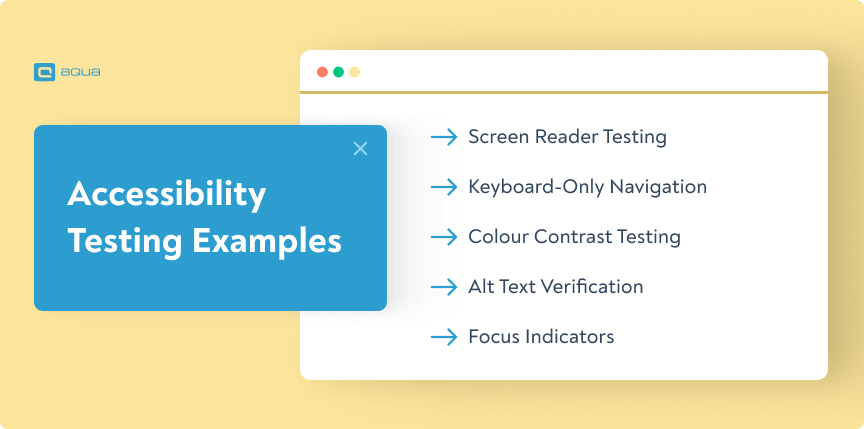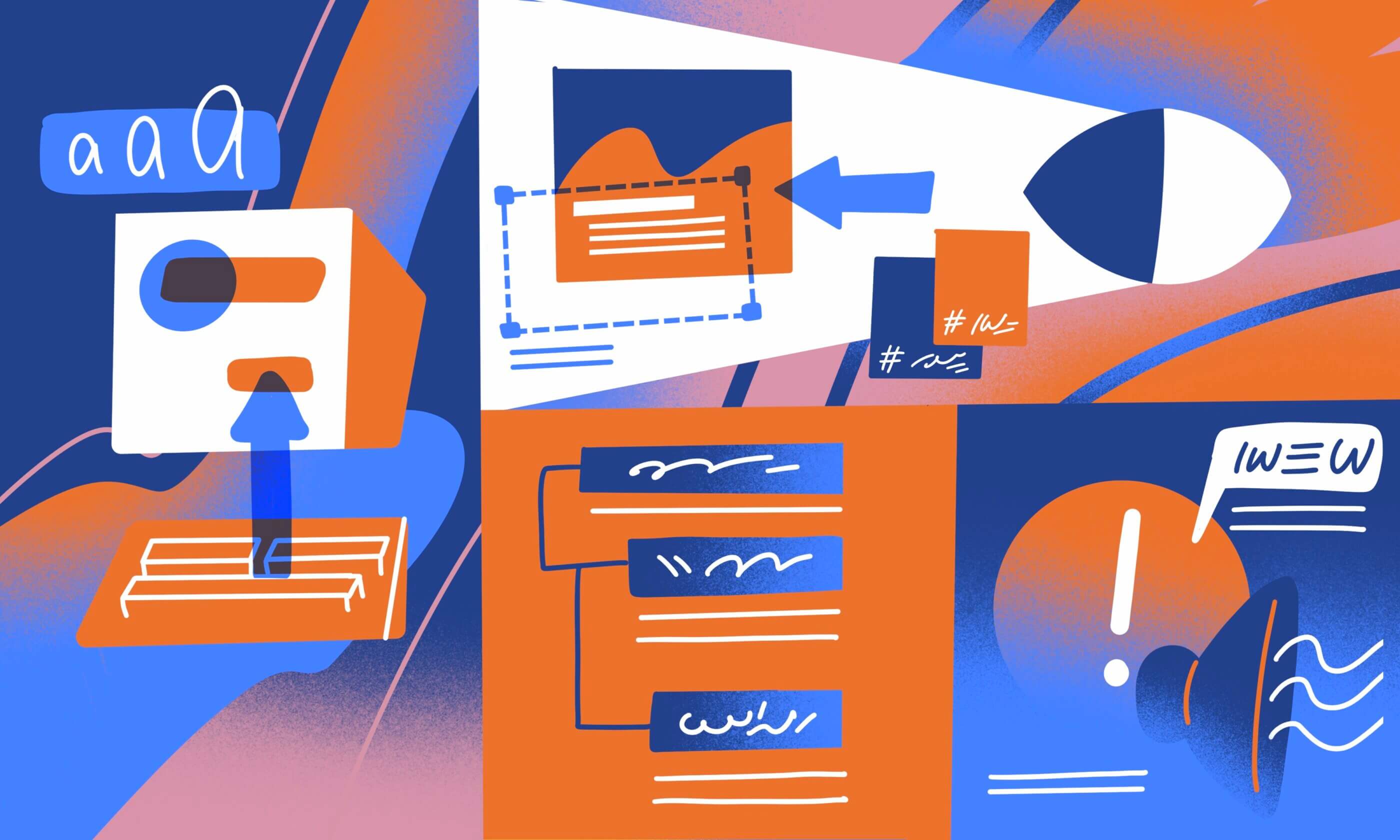What is accessibility testing?
Before we dive into testing, let’s start with digital accessibility first. To put it simply, digital accessibility means the accessibility of digital content for people with disabilities.
Here is how the situation looks in the digital landscape in 2024, according to AudioEye:
- 56% of images aren’t accessible to people with visual impairments.
- 93% of domains have at least one page with an inaccessible image.
- 60% of images lack alternative text (alt text).
Does not look good, does it? This situation makes accessibility testing a necessity. So, what is accessibility testing?
Accessibility testing is the process of evaluating digital content, websites, applications, and other digital products to ensure they are usable by people with disabilities. It aims to identify and address barriers that prevent individuals with disabilities from accessing or interacting with digital content.
The process involves various methods and tools, including:
- Automated tests that scan for common accessibility issues
- Manual tests conducted by human testers to evaluate user experience
- Testing with assistive technologies such as screen readers and magnifiers
The goal is to ensure that digital products meet accessibility standards such as the Web Content Accessibility Guidelines (WCAG). By carrying out this testing, you will have to comply with accessibility laws to provide equal access to all users. What are the accessibility laws, then?
Accessibility law is a set of regulations, standards, and guidelines that mandate digital content, websites, applications, and other technology to be accessible to individuals with disabilities.
Your ultimate goal with accessibility testing and law: ensuring people with disabilities have equal access to information and services provided through digital platforms.
But why is it getting popular and why it matters this much?
Importance and benefits of accessibility testing
Ensuring 100% digital accessibility is not just a moral thing to do. It is also a legal requirement in many regions. But are these the only 2 reasons why accessibility testing matters so much? Let’s look at the importance and benefits:
- Ensures Inclusivity: This is the main benefit, making sure people with disabilities can engage with content independently.
- Legal Compliance: Many countries have laws that require digital accessibility, like the Americans with Disabilities Act (ADA) in the U.S. or the European Accessibility Act in the EU, which will be mandatory on June 28, 2025. So accessibility testing helps you prevent legal concerns too.
- Enhances User Experience: By fixing accessibility barriers, you enhance the overall user experience for all users, not just those with disabilities. This, in turn, leads to increased user satisfaction and engagement.
- Builds Brand Reputation: Especially before it starts to become mandatory, if you demonstrate a commitment to accessibility, you enhance your reputation as socially responsible and inclusive. It shows that you value diversity and strive to provide equal opportunities for everyone.
- Reduces Development Costs: Tackling accessibility issues early in the development process is also more cost-effective than fixing them later. It helps prevent costly redesigns and redevelopment efforts.
- Improves SEO and Searchability: Accessible websites are more compatible with search engine algorithms. This way, you have a higher chance of improved search engine optimisation (SEO) and discoverability.
Overall accessibility testing ensures legal compliance and broadens audience reach while also enhancing user experience, building brand reputation, and contributing to cost savings in development.
Digital Accessibility Standards
When it comes to digital accessibility, you need to be aware of the standards that guide your efforts. When carrying out accessibility testing, these are the standards you should mainly focus on:
- European Accessibility Act
For those of you in Europe, the European Accessibility Act will soon require all digital services—especially in e-commerce, travel, and banking—to meet strict accessibility rules by June 2025. - WCAG (Web Content Accessibility Guidelines)
This is the global standard you should follow. It outlines the best practices for making your digital content accessible, focusing on four key principles: it must be perceivable, operable, understandable, and robust. - Section 508 (U.S.)
If you’re in the U.S., Section 508 requires all federal agencies and their partners to meet accessibility standards. Following this helps you comply with federal law and opens up opportunities for government contracts.
By following these standards, you ensure your content is inclusive, compliant, and ready for everyone. Next, we talk about the examples of accessibility testing, so it becomes crystal clear.
Accessibility Testing Examples
So, how do you make sure everyone can access your content easily? Here are some examples of accessibility testing you can perform to ensure your digital products are usable for everyone:
- Screen Reader Testing: In this example, you use screen readers like JAWS or NVDA to make sure your website or app can be easily navigated by people with visual impairments.
- Keyboard-Only Navigation: You can test if all parts of your website are accessible using just a keyboard. This is essential for users with motor disabilities who can’t use a mouse.
- Colour Contrast Testing: By checking the contrast between text and background colours, you ensure that content is readable for users with visual impairments. This also includes colour blindness.
- Alt Text Verification: This example involves ensuring all images have meaningful alt text. It aims at one thing: people using screen readers can understand the content of the images.
- Focus Indicators: This test determines whether interactive elements like buttons and links are highlighted properly when navigated using a keyboard. It helps users know where they are on the page.

By conducting these tests, you ensure comprehensive, modern, 100% quality assurance (QA). These practices are a part of a greater purpose, making sure your digital products (websites or apps) function smoothly, without any inconveniences or bugs. This is where you need a solution that will help you achieve flawless functionality and ultimate user experience.
Here comes aqua cloud, designed for much more than just accessibility testing. aqua helps you achieve seamless, complete testing by providing 100% traceability. It helps you streamline test management by offering a centralised repository, giving you 100% visibility into all your testing data. You have effortless test cases and test data creation in just three clicks with our AI-driven features, making software testing easier for everyone. Committed to inclusivity, we also have upcoming features to ensure the platform is accessible to users with disabilities. Ready to enhance your testing process and embrace a more inclusive approach? Give aqua cloud a try today.
Streamline 100% of your testing efforts with an AI-powered solution
What to test in accessibility testing?
When conducting accessibility testing, you have to focus on evaluating essential elements. Key areas you should prioritise:
- Navigation: Assess the navigability of the website or application using keyboard-only navigation, ensuring users can access all interactive elements without a mouse.
- Images and Alt Text: Verify that all images have descriptive alt text that conveys the purpose or content of the image to users who cannot see them.
- Headings and Structure: Check that content is organised using proper heading tags (h1, h2, etc.) and hierarchical structure. This aids users in navigating and understanding the content.
- Colour Contrast: Evaluate colour combinations to ensure there is sufficient contrast between text and background colours. This way, you make content readable for users with low vision or colour blindness.
- Multimedia Content: Ensure that audio and video content has captions, transcripts, and audio descriptions where necessary. This will allow users with disabilities to access the information conveyed.
- Responsive Design: Verify that the website or application is responsive and adapts seamlessly to different screen sizes and devices.
- Interactive Elements: Evaluate interactive elements (buttons, links, menus) for accessibility. Include focus indicators, keyboard accessibility, and functionality with assistive technologies.
- Error Handling: Check error messages and alerts for accessibility, ensuring they are conveyed through multiple modalities (visual, auditory) and provide clear guidance on resolving issues.
Focusing on these areas will help you meet fundamental accessibility requirements.
Now that you understand the key principles, it’s time to experience accessibility challenges firsthand. The interactive simulator below lets you toggle different accessibility conditions and see how they affect web browsing. Try each simulation mode while interacting with the sample content to gain valuable insights into the user experience of people with disabilities.
🎯 Accessibility Experience Simulator (Click to open)
Manual Accessibility Testing vs Automated Accessibility Testing
When it comes to ensuring digital accessibility, you have two primary methods at your disposal: manual and automated accessibility testing. Each approach offers distinct advantages and limitations. But they are complementary to a comprehensive accessibility testing strategy. Let’s look at the comparison table of these two:
| Aspect | Manual Accessibility | Automated Accessibility |
|---|---|---|
| Human involvement | Relies on human testers to evaluate accessibility issues and user experience. | Uses software tools to automatically scan for accessibility violations based on predefined rules. |
| Scope of Testing | Comprehensive testing covering usability, user experience, and contextual issues. | Focuses on identifying technical violations against accessibility standards and guidelines. |
| Detection of issues | Effective in detecting nuanced issues and usability challenges that affect users with disabilities. | Quickly identifies common and repetitive issues, such as missing alternative text or form labels. |
| Depth of Analysis | Provides qualitative insights and recommendations based on real user interactions and experiences. | Offers quantitative results and reports on specific violations with accuracy and speed. |
| Flexibility | Allows testers to adapt test scenarios and methodologies based on diverse user needs and real-world scenarios. | Limited by predefined algorithms and rules, which may miss context-specific or complex issues. |
| Skill Requirements | Requires skilled accessibility testers with knowledge of accessibility guidelines and assistive technologies. | Relies on technical expertise to set up and interpret automated tests, but less human expertise is needed for execution. |
| Cost and Time Efficiency | Time-consuming and potentially costly due to human resources and thorough testing processes. | Generally more cost-effective and faster for routine checks and repetitive tasks. |
In an ideal world, a balanced approach involves using both manual and automated accessibility testing methods. Manual testing helps you with a complete evaluation of user experience and contextual issues, while automated testing provides efficient checks for technical compliance. Together, they serve the same purpose: helping you create inclusive digital experiences for all users and achieve comprehensive accessibility standards.
Step-by-Step Process of Accessibility Testing
After identifying the key elements to test for accessibility, the next step is to implement a structured process to thoroughly evaluate and enhance the accessibility of your digital content. Here is a complete guide you to go through accessibility testing:
- Step 1 – Define Accessibility Standards and Goals: Identify which accessibility standards you are going to follow (WCAG, Section 508, European Accessibility Act).
- Step 2 – Conduct an Initial Assessment: Perform an initial automated scan using accessibility testing tools to identify common issues. Review the results to understand the scope and severity of accessibility problems.
- Step 3 – Manual Testing: Engage human testers, as well as people with disabilities, to manually evaluate usability and identify issues that automated tools may miss. Use assistive technologies (screen readers, keyboard navigation) to test the user experience.
- Step 4 – Fix Identified Issues: Address the issues you found during both automated and manual testing. Make necessary changes to code, design, and content to enhance accessibility.
- Step 5 – Validate Changes: Re-test the updated content using both automated tools and manual methods to ensure issues have been resolved. Validate that all accessibility improvements meet the defined standards and goals.
- Step 6 – Perform User Testing: Conduct usability testing with real users, including those with disabilities. Gather feedback on the accessibility of the content. Make additional adjustments based on user feedback to improve the overall accessibility and user experience.
- Step 7 – Document and Report: Document the accessibility testing process, findings, and fixes implemented. Create a detailed accessibility report that outlines compliance status, remaining issues, and recommendations for ongoing accessibility maintenance.
- Step 8 – Implement Continuous Monitoring: Set up regular accessibility audits and monitoring to ensure ongoing compliance and identify new issues as content is updated. Train your team on accessibility best practices to maintain and improve accessibility over time.
By following this step-by-step process, you can systematically evaluate, enhance, and maintain the accessibility of your digital content.
Test case examples for accessibility testing
Creating specific test cases is also essential for systematically evaluating the accessibility of digital content. Here are some examples of test cases that can be used in accessibility testing:
Test Case 1: Keyboard Navigation
Objective: Ensure all interactive elements are accessible via keyboard.
Steps:
- Navigate through the website using the Tab key.
- Verify that each interactive element (links, buttons, form fields) receives focus in a logical order.
- Ensure that keyboard users can activate elements using the Enter or Spacebar keys.
Expected Result: All interactive elements are accessible and operable via keyboard navigation.
Test Case 2: Screen Reader Compatibility
Objective: Ensure content is accessible to screen reader users.
Steps:
- Open the website or application with a screen reader (e.g., NVDA, JAWS).
- Navigate through the content, listening to how the screen reader announces elements.
- Check that all images have descriptive alt text, headings are properly structured, and interactive elements are labelled.
Expected Result: The screen reader accurately describes all content and interactive elements.
Test Case 3: Colour Contrast
Objective: Ensure text has sufficient contrast against background colours.
Steps:
- Use a colour contrast analyser tool to check the contrast ratio of text and background colors.
- Verify that the contrast ratio meets the minimum WCAG 2.1 AA standards (4.5:1 for normal text, 3:1 for large text).
Expected Result: All text elements meet or exceed the required contrast ratios.
These examples provide a structured approach to evaluating key aspects of digital accessibility. If you noticed, we have mentioned accessibility testing tools above. Now it’s time to talk about these tools.
Best tools for accessibility testing
When it comes to accessibility testing, there are several excellent tools available that cater to different aspects of ensuring digital products are accessible to all users. Here are some of the best tools widely used in the industry:
- WAVE (Web Accessibility Evaluation Tool): WAVE evaluates web content for accessibility issues directly within the browser. It provides detailed reports and guidance for improving accessibility.
- axe Accessibility Checker: axe is an open-source tool that integrates into development environments to automate accessibility testing based on WCAG standards, offering actionable insights for fixing issues.
- Pa11y: Pa11y is an automated accessibility testing tool that helps developers identify and address accessibility issues in web pages, suitable for integration into continuous integration workflows.
- NVDA (NonVisual Desktop Access): NVDA is a free, open-source screen reader for Windows that enables blind and visually impaired users to navigate and interact with digital content.
- Colour Contrast Analysers: Tools like WebAIM’s Color Contrast Checker help ensure that text and interactive elements on websites meet accessibility standards by verifying sufficient color contrast ratios.
- Accessibility Insights: Provided by Microsoft, Accessibility Insights offers a suite of tools and browser extensions for developers to find, fix, and prevent accessibility issues during development.
- Tenon.io: Tenon is an accessibility testing platform that combines automated and manual testing capabilities, providing comprehensive reports and integration options for accessibility testing.
- Lighthouse (part of Google Chrome DevTools): Lighthouse is an open-source tool that audits web pages for performance, accessibility, SEO, and more, offering actionable suggestions for improving web page quality.
However, in digital QA, realistically you won’t use tools for only one niche purpose. You’ll need a comprehensive solution that integrates various testing needs into one platform. This is where a modern solution that has everything comes in handy.
Here comes aqua cloud, designed for much more than just accessibility testing. With the power of AI, aqua is the ultimate solution for QA professionals of all levels. aqua provides you with a central depository of all your testing data while helping you save time and resources. Test case and test data creation in a few seconds, effortless requirements management, AI-driven test prioritisation, seamless integrations with various automation frameworks, all for one purpose: taking the pain of testing from you. Ready to streamline the whole process? Give aqua cloud a go.
Step into the future of software testing and join 100s of QA teams today
Conclusion
In this guide, you’ve learned why accessibility testing is crucial for both inclusivity and compliance. We’ve covered key strategies and tools for effective testing, and how you can ensure your digital content meets accessibility standards. With all these insights, you’re now equipped to enhance user experience, avoid legal problems, and broaden your audience. Now it’s time to rely on a solution like aqua cloud and embrace these practices to lead in accessibility and deliver exceptional digital experiences.


















